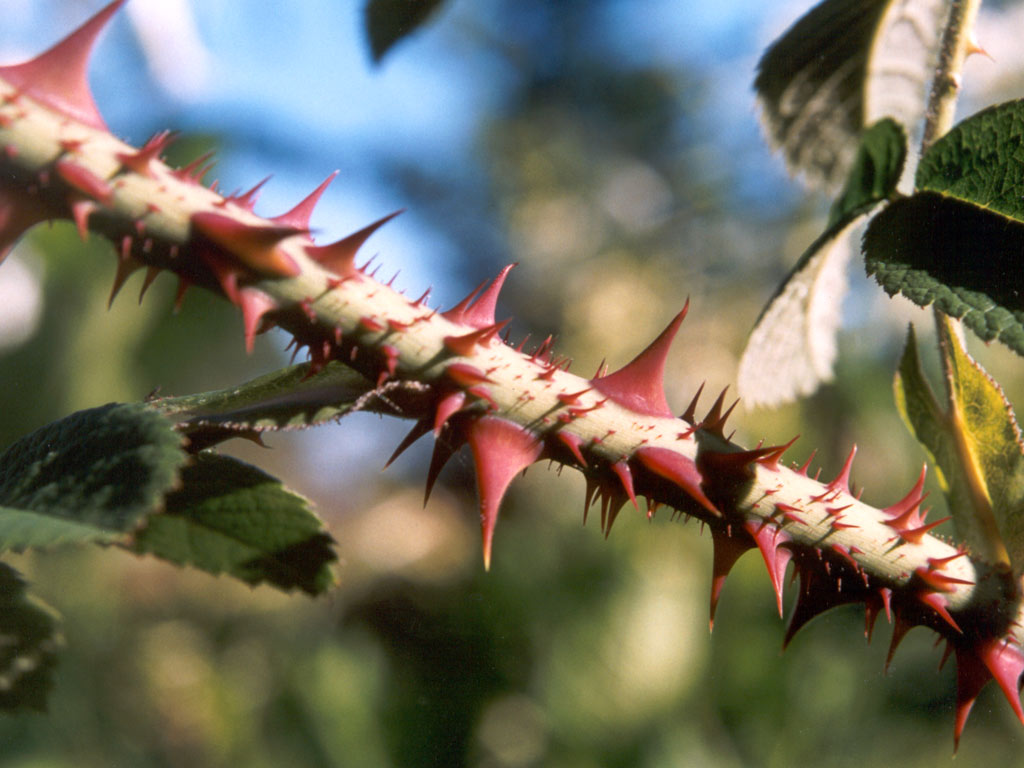- Photograph first magnificent saguaro you see
- Stand back, tilt head and ponder deeply
- Approach slowly, cautiously and:

For some reason completely incomprehensible to those of us raised around these bristly flora, tourists are absolutely obsessed with touching cacti - particularly the saguaro. When I finally found a tourist I felt comfortable enough with to ask, their reason was "to see if it was really sharp and thorny".
Well, duh, says the girl who's pulled cholla thorns out of her dog's tongue. Why do you think they're called thorns?
But are they? Are they really called thorns?
A matter not only for the Queen of Useless Knowledge - but closely related to my hunt for the wild Boojum. Well, maybe not closely, but boojums have "thorns" too, so there is a connection here. And I needed a tidy segue into my next informative piece.
 A boojum's spikey, happy branches in the sun (wrl)
A boojum's spikey, happy branches in the sun (wrl)You see, there is a fundamental difference between thorns and spines - and it helps to define the defense systems of our desert adapted plants from those of more ostentatious species. A thorn is essential a small, leafless stem or branch.

So, the thorn is a woody appendage, usually connected to a branch, and not really related to the leaves (except perhaps in it's location, such as the velvet mesquite which has thorns tucked into the junction of the petiole and the stem - a clever and sneaky adaptation).
But a spine, ah, a spine is actually modified leaf. I know, pretty amazing, huh. Perhaps this illustration from Wayne's World Online Textbook of Natural History (hey, I only consult the best sources) will help to illustrate this very important difference:

Ach, see! "A" is a thorn - independent of the leaf and woody(can't you tell from the illustration?). "B" is a spine - actually a part of the leaf growth! Coolio!
So, on my beautiful boojum it gets EVEN MORE INTERESTING! (I know, I didn't think it was possible, either). Unlike other desert adapted plants like the barrel cactus and the prickly pear whose spines are essentially always spines and never traditional "leaves", the plants in the family Foquieriacaea (ocotillo, boojum, tree ocotillo) actually grow a leaf with a long, stiff petiole (the part that connects the leaf to the stem). When the desert is drenched with rain during the monsoons, the leaves sprout out from the succulent stems with amazing speed. Then, when the heat is back on and the plant needs to conserve water, it drops the leaves. But the long, stiff petiole is retained and becomes what botanists call a 'fouquieriaceous' spine. Another illustration from Wayne's World:

Here's a close up on the plant. (come on, tell me this isn't sexy)

In the photo, the leaf is a second-growth leaf, meaning that the original leaf fell off and left the remaining spine, then the wet season, a leaf regrew from the same spot - this one won't leave a new spine. Nature can be so efficient!
So, now if someone tells you that you have a thorny disposition, you will know they're referring to your stems, not your leaves. It'll ease the sting significantly (at least it does for me).
An image for the individual who requested proof of the intimidating Boojum at the Boyce Thompson Arboretum:
 More than 35' of Boojum glory! (wrl)
More than 35' of Boojum glory! (wrl)Also of interest, though not really related.... While searching the web for photos for this post, I came across the web site of a couple that did a self-supported (read tent and hauled food) bicycle trip throughout southeastern Arizona on their tandem with their two-year-old in a little trailer behind them. Amazing stuff - they rode from Tucson through Sonoita to Tombstone and back through Green Valley. With a toddler in a trailer. Them's some admirable, but crazy, folks there.
Comments